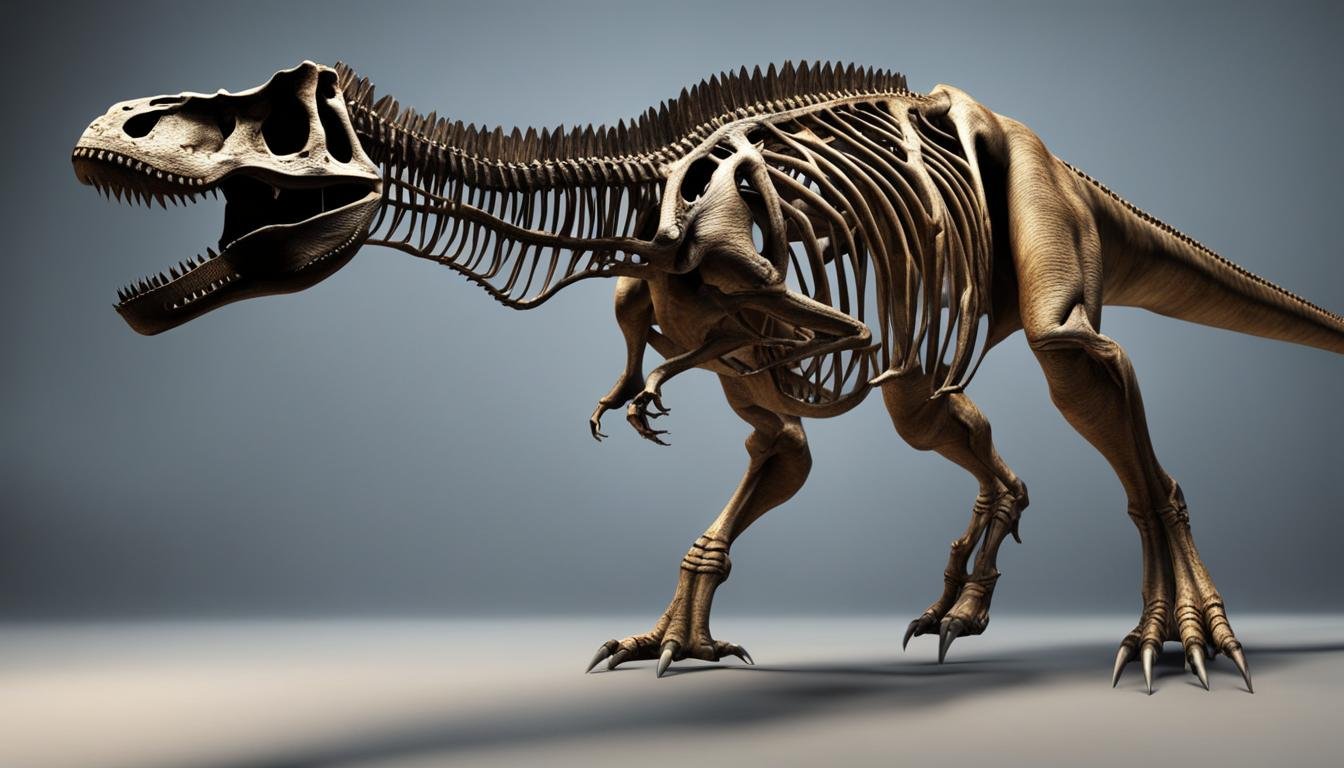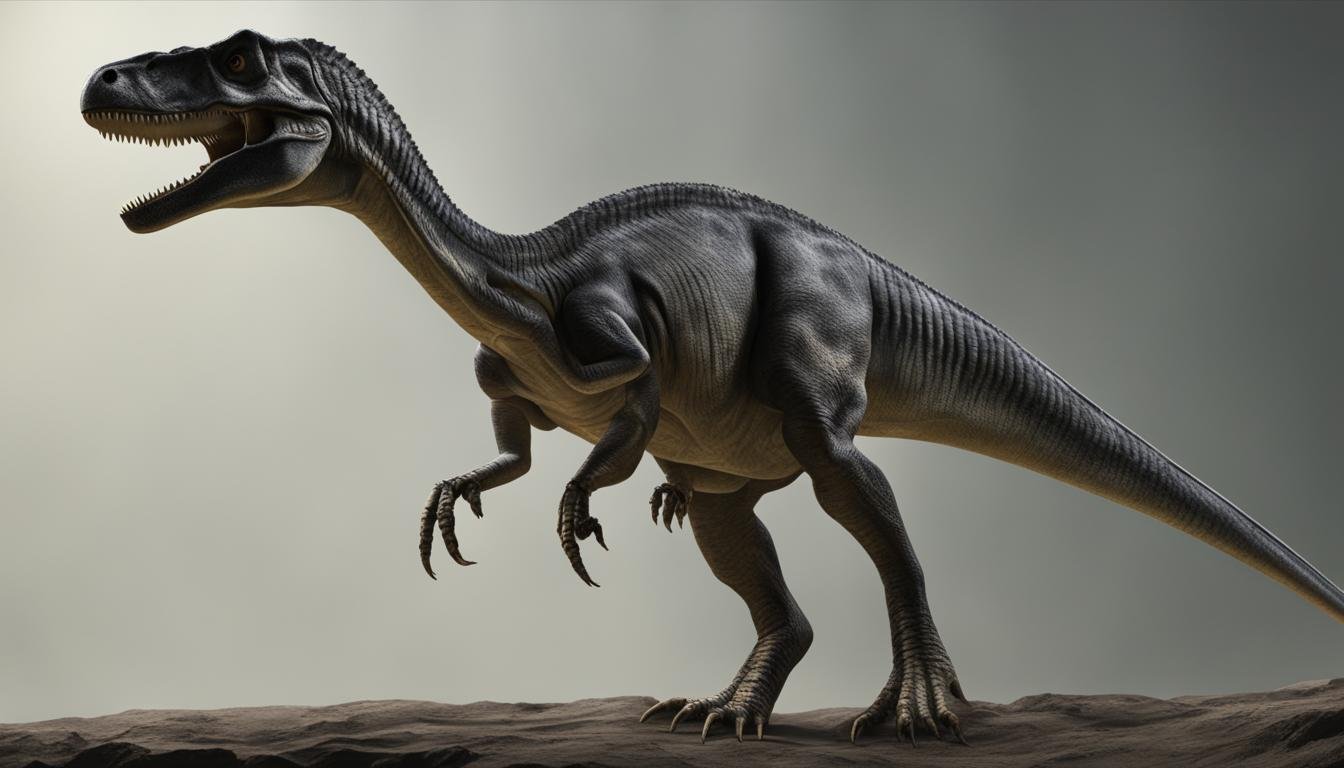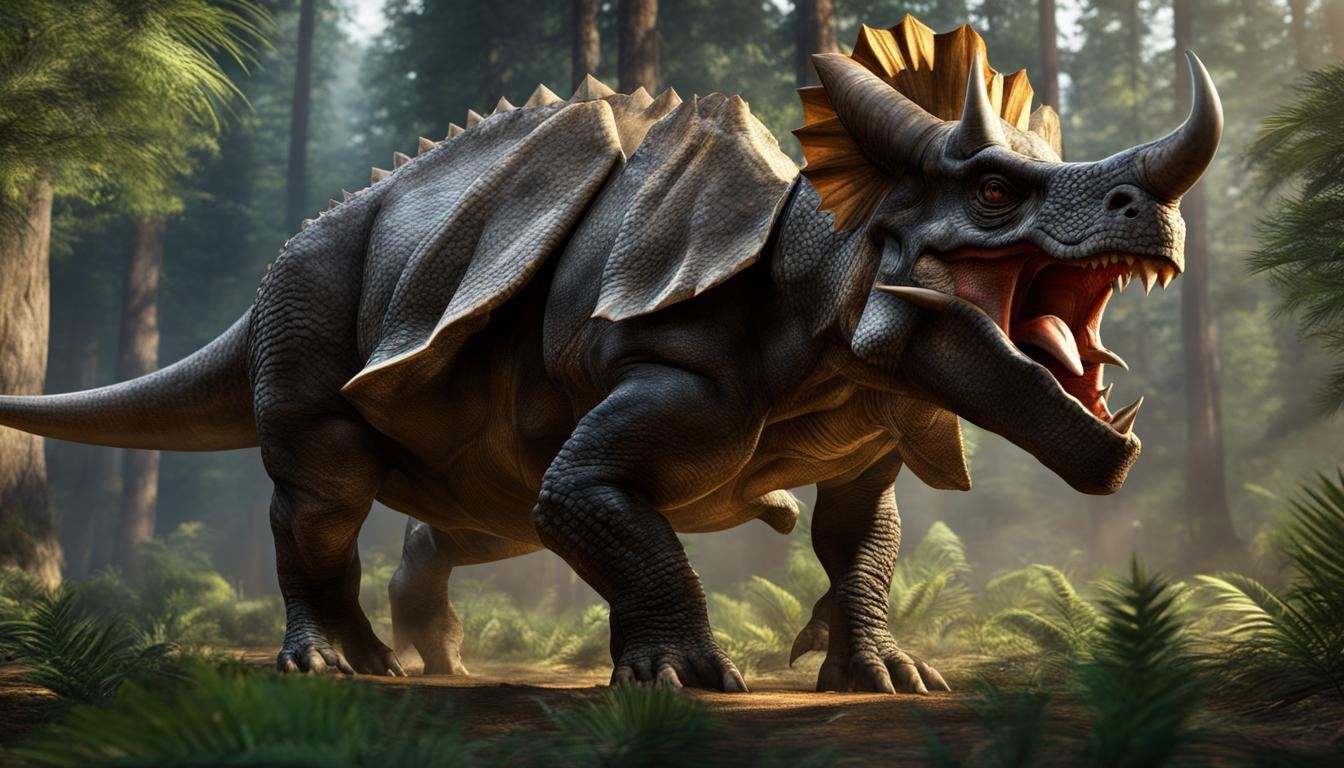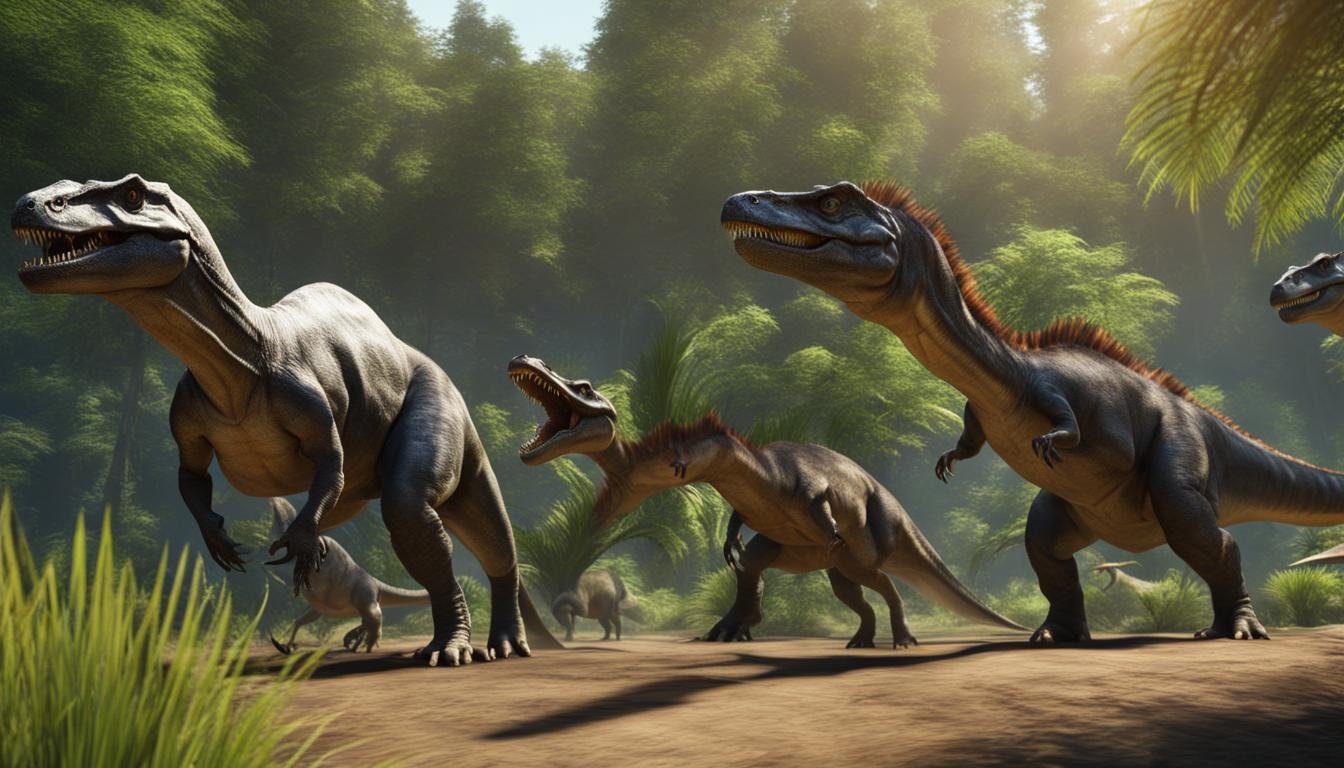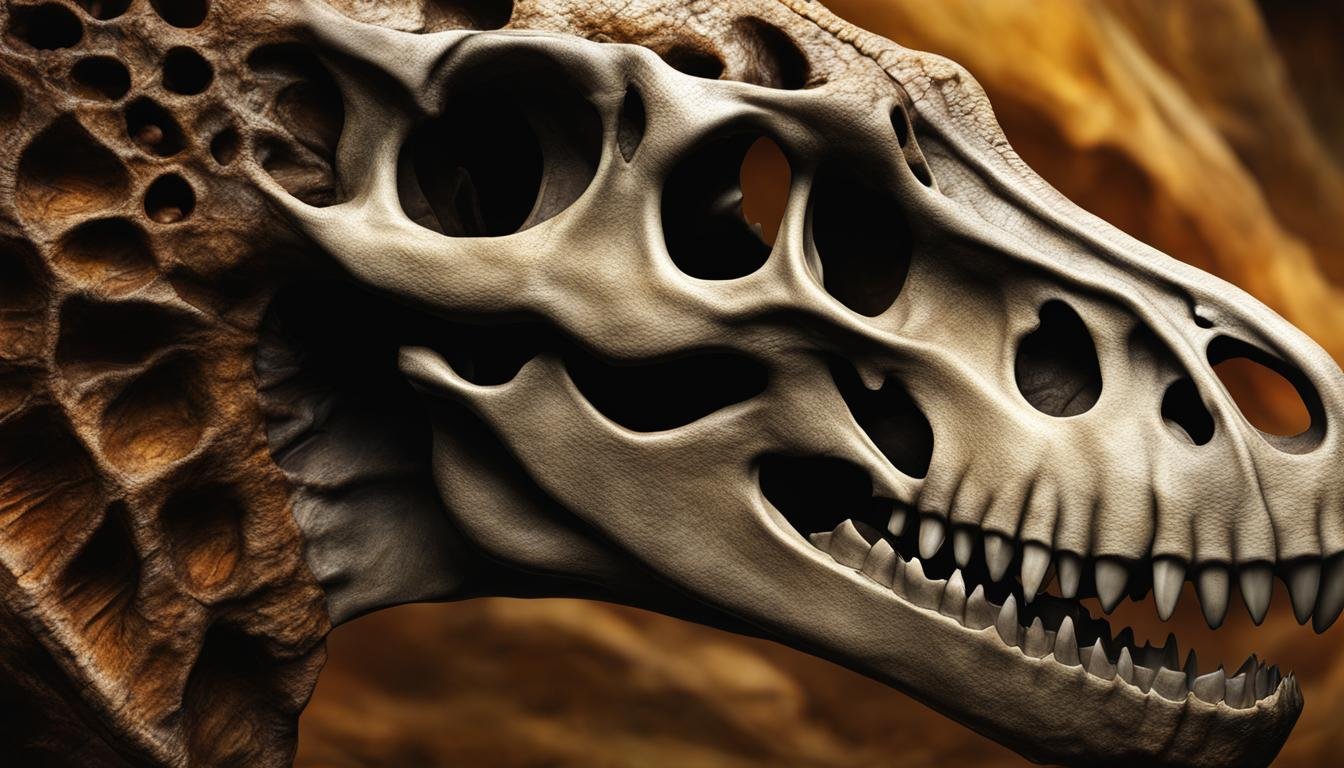Welcome to the fascinating world of dinosaur anatomy! In this article, we will explore the structure and function of the bones, skulls, teeth, and other skeletal features of these ancient creatures. By delving into the world of dinosaur anatomy, scientists gain valuable insights into their evolution, behavior, and the prehistoric environment they inhabited.
Classification and Orientation Terms
When discussing dinosaur anatomy, it is essential to understand the classification and orientation terms used to describe the direction and position of different skeletal structures. These terms provide a standardized language that allows scientists to accurately communicate and compare the anatomical features of dinosaurs. Here are some of the key terms:
- Anterior: Refers to the front or head end of a dinosaur.
- Posterior: Refers to the back or tail end of a dinosaur.
- Dorsal: Indicates the upper side or back of a dinosaur.
- Ventral: Indicates the lower side or belly of a dinosaur.
- Medial: Refers to the middle or midline of a dinosaur.
- Lateral: Indicates the side of a dinosaur.
- Proximal: Describes a structure that is closer to the body or point of attachment.
- Distal: Describes a structure that is further away from the body or point of attachment.
By using these classification and orientation terms, scientists can accurately describe and compare the anatomical features of different dinosaur species, helping to shed light on their evolution, behavior, and ecology.
| Term | Definition |
|---|---|
| Anterior | Refers to the front or head end of a dinosaur. |
| Posterior | Refers to the back or tail end of a dinosaur. |
| Dorsal | Indicates the upper side or back of a dinosaur. |
| Ventral | Indicates the lower side or belly of a dinosaur. |
| Medial | Refers to the middle or midline of a dinosaur. |
| Lateral | Indicates the side of a dinosaur. |
| Proximal | Describes a structure that is closer to the body or point of attachment. |
| Distal | Describes a structure that is further away from the body or point of attachment. |
Understanding these terms allows scientists to accurately describe the position and direction of different skeletal structures in dinosaurs. This knowledge is crucial for studying their evolution, behavior, and overall anatomy.
Posture of Dinosaurs
The posture of dinosaurs varied greatly, reflecting their diverse adaptations and lifestyles. Some dinosaurs were bipedal, meaning they walked on their hind legs, similar to modern birds and humans. This posture allowed for efficient movement and the evolution of specialized features such as elongated hindlimbs and tail balancing.
On the other hand, there were dinosaurs that adopted a quadrupedal posture, walking on all four limbs. This body structure provided stability and support for larger and heavier dinosaurs, enabling them to navigate their environments and forage for food.
In addition to bipedal and quadrupedal postures, certain dinosaurs had unique postural adaptations. Some dinosaurs had a sprawling posture, where their limbs were placed far apart from the body. This posture was typically seen in aquatic or semi-aquatic dinosaurs, allowing for efficient movement in water. Other dinosaurs had a semi-erect or fully upright posture, similar to modern mammals. This posture facilitated efficient locomotion on land and may have been advantageous for capturing prey or avoiding predators.
Anatomical Features and Posture
The postures of dinosaurs were influenced by various anatomical features. For bipedal dinosaurs, the elongated hindlimbs and tail acted as counterbalances, allowing for efficient movement and agility. Quadrupedal dinosaurs had a more robust and stable body structure, with their limbs positioned directly under the body. This arrangement provided support for their massive size and allowed for effective weight distribution.
Furthermore, the presence of specialized adaptations, such as webbed feet or elongated limbs, in certain dinosaurs with sprawling postures facilitated movement in aquatic or marshy environments. In contrast, dinosaurs with semi-erect or upright postures had a more compact and streamlined body structure, enabling rapid and efficient movement on land.
| Posture | Characteristics |
|---|---|
| Bipedal | Elongated hindlimbs and tail for balance and agility |
| Quadrupedal | Robust body structure and limbs positioned directly under the body for stability and weight distribution |
| Sprawling | Limbs placed far apart for efficient movement in water or marshy environments |
| Semi-erect/Upright | Compact and streamlined body structure for rapid and efficient movement on land |
Understanding the posture of dinosaurs provides valuable insights into their behavior, locomotion, and ecological roles. By studying their anatomy and postural adaptations, scientists can reconstruct the dynamic and diverse world of dinosaurs and further unravel the mysteries of these fascinating ancient creatures.
The Skeleton of Dinosaurs
The skeleton of a dinosaur is a complex structure composed of different sections, each serving a specific purpose in supporting the dinosaur’s body and facilitating movement. Understanding the anatomy of the skeleton is essential for gaining insights into the evolution, behavior, and physical capabilities of these prehistoric creatures.
The main sections of a dinosaur’s skeleton include the skull, the axial skeleton, and the appendicular skeleton. The skull provides protection for the brain and sensory organs, and it also plays a role in feeding. The axial skeleton consists of the spine, ribs, neck, trunk, and tail, which together provide support and flexibility. The appendicular skeleton includes the forelimbs, hindlimbs, and their respective girdles, enabling locomotion and supporting the body’s weight.
Anatomy of the Skull
The skull of a dinosaur is a complex structure composed of several bones, each with its own distinct features and functions. These bones include the orbit (eyesocket), naris (nostril socket), antorbital fenestra, premaxilla, maxilla, lacrimal, temporal fenestrae, and dentary. The skull’s anatomy provides important clues about the dinosaur’s sensory capabilities, feeding habits, and evolutionary relationships.
Anatomy of the Axial Skeleton
The axial skeleton of a dinosaur is made up of the vertebral column, consisting of individual vertebrae. Each vertebra contains a centrum, neural arch, neural canal, transverse processes, and neural spine. The axial skeleton provides support for the dinosaur’s body, protects the spinal cord, and allows for flexibility in movement.
Anatomy of the Appendicular Skeleton
The appendicular skeleton of a dinosaur includes the pectoral girdle (shoulder girdle), forelimbs, pelvic girdle, and hindlimbs. The pectoral girdle consists of bones like the scapula, coracoid, clavicle, and sternum, which connect the forelimbs to the axial skeleton. The hindlimbs include bones such as the femur, tibia, and fibula, which provide support and enable the dinosaur to walk or run.
In summary, the skeleton of a dinosaur is a complex and fascinating structure that provides valuable insights into their physical capabilities and evolutionary history. By studying the anatomy of the skull, axial skeleton, and appendicular skeleton, scientists can piece together the puzzle of how these ancient creatures lived and moved in their prehistoric world.
Teeth and Dentition of Dinosaurs
Dinosaur teeth were remarkable structures that played a crucial role in their survival and adaptation. The composition of dinosaur teeth consisted of dentine and enamel, much like our own teeth. Enamel, the outer layer of the teeth, provided a protective coating, making the teeth more resistant to wear and tear. The density and thickness of the enamel varied between different dinosaur species, reflecting their diet and feeding habits.
One fascinating feature of dinosaur teeth is the presence of serrations or denticles along the edges. These serrations acted like small saw-like structures, allowing dinosaurs to effectively tear and slice through their food. The shape and arrangement of these serrations varied among different species, depending on their specific dietary preferences. Some dinosaurs had robust, closely spaced serrations, indicating a carnivorous diet, while others had more rounded, widely spaced serrations, suggesting a herbivorous or omnivorous diet.
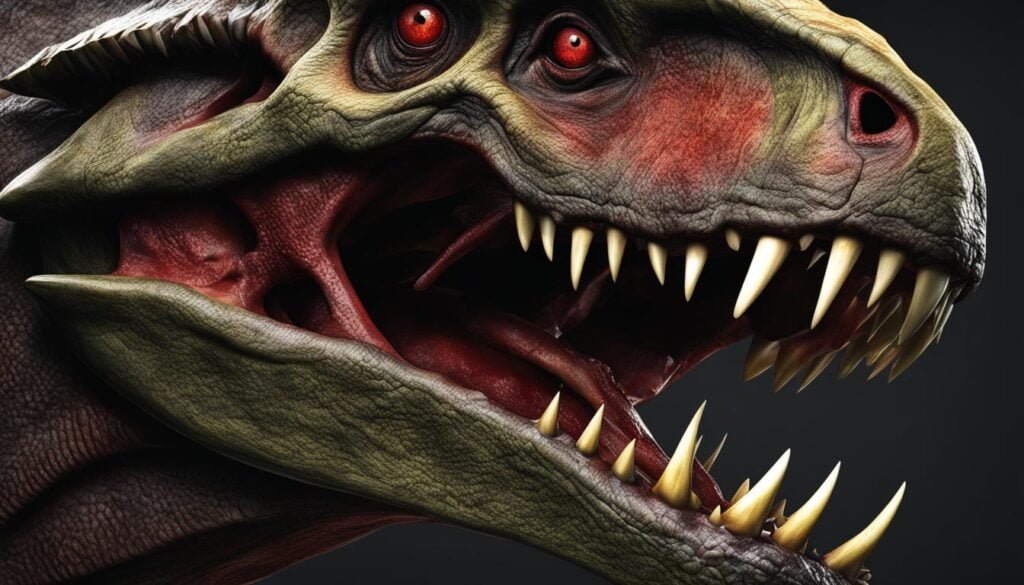
“The serrations on dinosaur teeth provide us with valuable insights into their feeding behavior,” says Dr. Jane Foster, a leading paleontologist. “By studying the shape and arrangement of these serrations, we can infer whether a dinosaur was a predator, scavenger, or herbivore. It’s like deciphering their dietary fingerprint.”
The study of dinosaur dentition also helps scientists understand how teeth grew and were replaced. Unlike mammals, where adult teeth are typically permanent, dinosaur teeth exhibited continuous growth and replacement throughout their lives. This constant replacement ensured that dinosaurs always had functional teeth for feeding, even if they lost or broke a tooth during their lifetime.
Dinosaur Skull Anatomy
The skull of a dinosaur is a complex structure composed of various bones and features that provide vital functions for the dinosaur’s survival. Understanding the anatomy of the dinosaur skull can offer insights into their sensory capabilities, feeding behaviors, and evolutionary adaptations. Let’s explore some key elements of dinosaur skull anatomy:
Naris
The naris, or nostril socket, is an essential feature of the dinosaur skull. It is the opening through which dinosaurs respired and is crucial for their sense of smell. The size and position of the naris can vary among different dinosaur species, providing clues about their olfactory abilities and how they interacted with their environment.
Antorbital Fenestra
The antorbital fenestra is a large opening located in front of the eye socket, commonly seen in many dinosaur species. This fenestra played a role in reducing the skull’s weight, making it more efficient for locomotion. The size and shape of the antorbital fenestra can vary among species and may have served additional functions, such as housing jaw muscles or contributing to visual acuity.
Maxilla and Premaxilla
The maxilla and premaxilla are bones that make up the upper jaw in dinosaurs. These bones support the teeth and play a crucial role in feeding and prey capture. The shape, size, and arrangement of teeth on the maxilla and premaxilla can provide valuable information about the diet and feeding habits of different dinosaur species.
Temporal Fenestrae
The temporal fenestrae are openings located on the sides of the dinosaur skull. These fenestrae served as attachment points for jaw muscles, allowing for powerful biting and chewing. The size and shape of the temporal fenestrae can vary among different dinosaur groups, indicating differences in their feeding strategies and cranial strength.
| Skull Feature | Function |
|---|---|
| Antorbital Fenestra | Reduced skull weight, potential visual and muscular functions |
| Naris | Sensory capabilities, olfaction |
| Maxilla and Premaxilla | Support teeth, feeding |
| Temporal Fenestrae | Jaw muscle attachment, biting and chewing |
In summary, the skull of a dinosaur is a complex structure with various features serving different functions. The naris, antorbital fenestra, maxilla, premaxilla, and temporal fenestrae all provide valuable insights into the sensory capabilities, feeding behaviors, and evolutionary adaptations of dinosaurs. By studying the intricate anatomy of dinosaur skulls, scientists can uncover the secrets of these fascinating creatures and better understand their place in the ancient world.
Anatomy of the Axial Skeleton
The axial skeleton of a dinosaur consists of various components that provide structure and support. Understanding the anatomy of the axial skeleton is crucial for comprehending the overall body structure and movement of these ancient creatures.
Vertebrae
The vertebrae are the building blocks of the axial skeleton. They make up the backbone of dinosaurs and are responsible for providing flexibility and support. Each vertebra consists of several key features, including:
- The centrum, which forms the main body of the vertebra.
- The neural arch, which protects the spinal cord.
- The neural canal, a hollow space through which the spinal cord passes.
- Transverse processes, which project from the sides of the vertebra and provide attachment points for muscles and ligaments.
- The neural spine, which extends upwards from the neural arch and aids in muscle attachment.
Gastralia
In addition to the vertebrae, some dinosaurs also possessed gastralia, also known as belly ribs. These were long, thin bones that ran along the underside of the body, offering additional support and protection. The presence of gastralia varied among different dinosaur species and played a role in their overall body structure and movement.
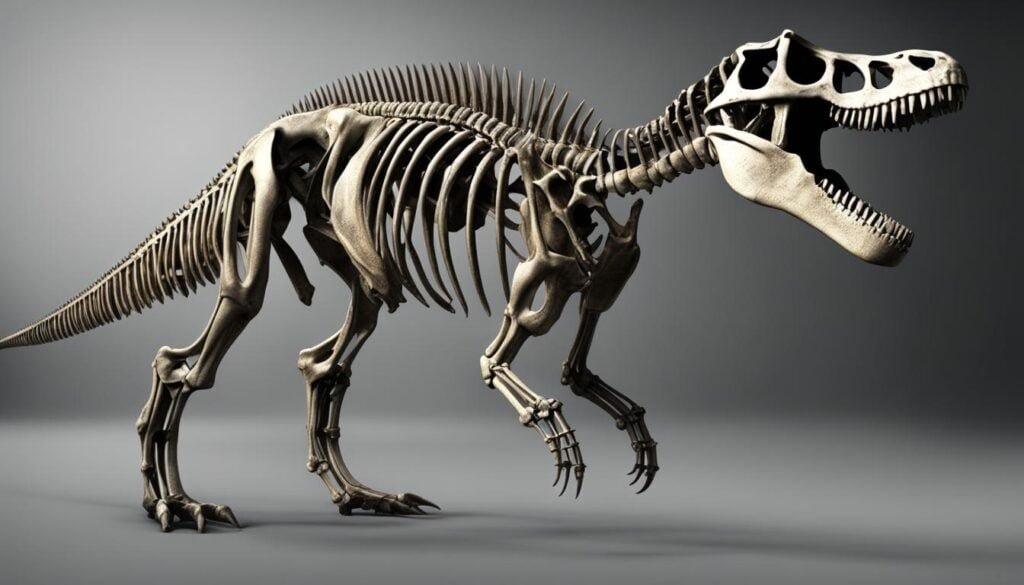
“The axial skeleton is critical in understanding the biomechanics of dinosaurs. It provides the foundation for their movements and supports the weight of their bodies.”
By studying the vertebrae and gastralia of dinosaurs, paleontologists can gain insights into their locomotion, posture, and evolutionary adaptations. These skeletal features offer valuable clues about how dinosaurs moved and interacted with their environment, allowing us to visualize these fascinating creatures in a more comprehensive way.
| Component | Function |
|---|---|
| Vertebrae | Provide flexibility and support for the backbone |
| Gastralia | Offer additional support and protection |
Anatomy of the Appendicular Skeleton
The appendicular skeleton of a dinosaur consists of various bones and structures that play a crucial role in their movement and mobility. It includes the pectoral girdle, forelimb, pelvic girdle, and hindlimb. Let’s explore the key components of the appendicular skeleton:
Pectoral Girdle
The pectoral girdle, also known as the shoulder girdle, connects the forelimb to the axial skeleton. It comprises bones such as the scapula, coracoid, clavicle, and sternum. These bones provide support and attachment points for the forelimb muscles, enabling dinosaurs to move their arms and manipulate objects.
Forelimb
The forelimb of a dinosaur consists of multiple bones, including the humerus, radius, ulna, and a variety of smaller bones in the wrist and hand. These bones work together to provide flexibility and strength, allowing dinosaurs to perform various functions such as grasping, digging, or striking.
Pelvic Girdle
The pelvic girdle, also known as the hip girdle, connects the hindlimb to the axial skeleton. It consists of bones like the ilium, ischium, and pubis. The pelvic girdle provides stability and support for the hindlimbs, enabling dinosaurs to walk, run, or engage in other forms of locomotion.
Hindlimb
The hindlimb of a dinosaur comprises bones such as the femur, tibia, fibula, and various bones in the ankle and foot. These bones are specialized for weight-bearing and locomotion. The hindlimbs of different dinosaur species exhibit significant variations in size, shape, and adaptations, reflecting their diverse ecological niches.
The appendicular skeleton of dinosaurs, including the pectoral girdle, forelimb, pelvic girdle, and hindlimb, played a crucial role in their mobility, allowing for various forms of locomotion and specialized functions. By studying these skeletal structures, scientists can gain insights into the biomechanics and evolutionary adaptations of dinosaurs.
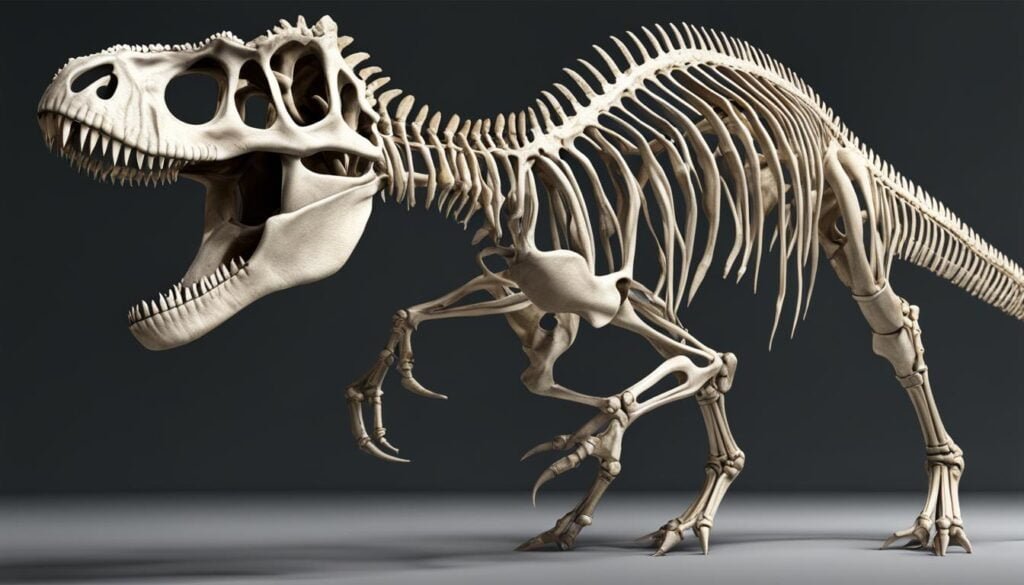
| Bone | Function |
|---|---|
| Pectoral Girdle | Connects forelimb to axial skeleton; provides support and attachment for arm muscles |
| Forelimb | Enables grasping, digging, or striking; performs various functions depending on species |
| Pelvic Girdle | Connects hindlimb to axial skeleton; provides stability and support for hindlimbs |
| Hindlimb | Enables weight-bearing and locomotion; exhibits variations in size, shape, and adaptations |
Evolutionary Significance
The study of dinosaur anatomy provides valuable insights into their evolution and adaptations. By examining the anatomical structures of different dinosaur species, scientists can uncover evolutionary relationships and understand how these ancient creatures adapted to their environments. Two important concepts in the study of dinosaur anatomy are homologous structures and analogous structures.
Homologous Structures
Homologous structures are similar anatomical features found in different species that share a common ancestor. These structures may have different functions in each species but have a similar underlying structure. For example, the forelimbs of birds, bats, and humans all have the same basic bone structure, despite their different functions. By studying homologous structures in dinosaurs, scientists can trace the evolutionary changes that led to the diverse range of anatomical adaptations observed in various species.
Analogous Structures
Analogous structures, on the other hand, serve the same function but have different anatomical origins. These structures have evolved independently in different species to perform similar tasks. For example, the wings of birds and bats are analogous structures because they both evolved for flight, but their underlying skeletal structures are different. The study of analogous structures in dinosaurs helps scientists understand how different species adapted to similar ecological niches and developed similar functional adaptations.
The understanding of homologous and analogous structures in dinosaur anatomy is crucial for reconstructing the evolutionary history and ecological diversity of these prehistoric creatures. By analyzing the anatomical features of dinosaurs, scientists can gain a deeper understanding of the adaptations that allowed them to thrive and dominate the Earth for millions of years.
| Homologous Structures | Analogous Structures |
|---|---|
| – Similar anatomical features – Shared common ancestor – Different functions – Similar underlying structure | – Serve the same function – Different anatomical origins – Evolved independently – Similar functional adaptations |
| Example: Forelimbs of birds, bats, and humans | Example: Wings of birds and bats |
Anatomical Directions and Landmarks
When studying dinosaur anatomy, it is essential to understand the anatomical directions and landmarks used to describe the position and structure of different body parts. These terms help scientists accurately identify and study the various components of dinosaur anatomy. Let’s explore some of the key anatomical directions and landmarks:
Anatomical Directions
- Anterior: Refers to the front or head end of the dinosaur.
- Posterior: Refers to the back or tail end of the dinosaur.
- Dorsal: Refers to the upper side or back of the dinosaur.
- Ventral: Refers to the lower side or belly of the dinosaur.
- Medial: Refers to the midline or middle of the dinosaur.
- Lateral: Refers to the sides of the dinosaur.
- Proximal: Refers to a body part that is closer to the dinosaur’s main body.
- Distal: Refers to a body part that is farther away from the dinosaur’s main body.
Anatomical Landmarks
There are several anatomical landmarks on the dinosaur skeleton that help scientists identify and study specific features. Here are some notable landmarks:
- Orbit: The eyesocket of the dinosaur.
- Naris: The nostril socket of the dinosaur.
- Antorbital Fenestra: An opening in front of the eyesocket.
- Premaxilla: The front bone of the upper jaw.
- Maxilla: The main bone of the upper jaw.
- Lacrimal: A bone near the eyesocket.
- Temporal Fenestrae: Openings on the side of the skull for jaw muscle attachment.
- Dentary: The main bone of the lower jaw.
By understanding these anatomical directions and landmarks, scientists can accurately describe and analyze the intricate structures of dinosaur anatomy, providing valuable insights into their evolution and behavior.
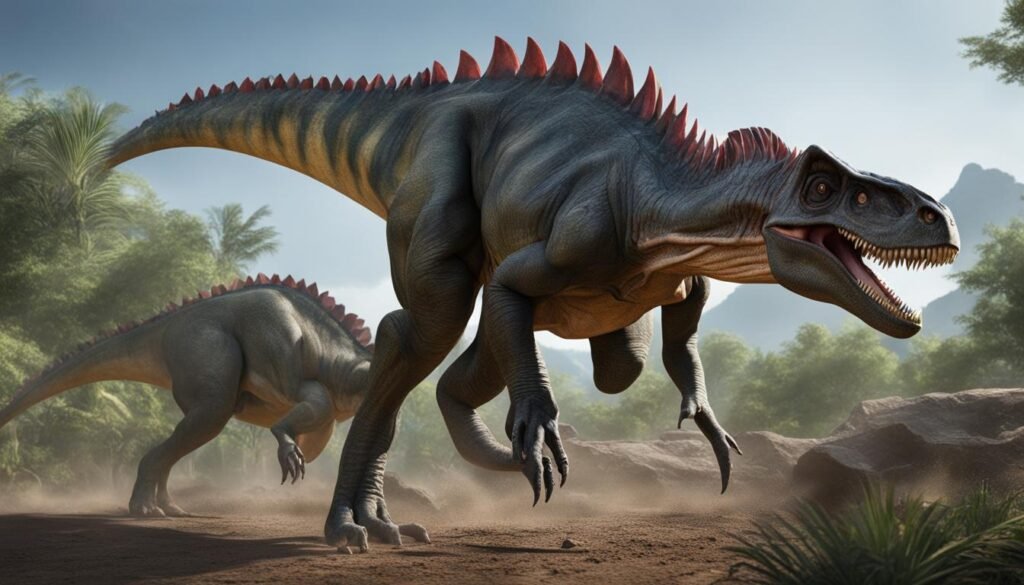
Function of the Skeleton
Dinosaur skeletons served various important functions to support their bodies and enable them to thrive in their prehistoric environments. Let’s explore the key roles played by the skeletal system of dinosaurs:
- Support: The skeleton provided a strong framework that supported the body weight of dinosaurs, allowing them to stand and move. The vertebrae in the spinal column provided flexibility and stability, while the ribs protected vital organs such as the heart and lungs.
- Protection: The skeletal system of dinosaurs provided protection for their internal organs. The skull, for instance, safeguarded the brain and sensory organs like the eyes and nose. Additionally, the ribs shielded the vital organs in the chest region, providing a layer of defense against external threats.
- Mechanical Structures: Joints, ligaments, and tendons in the skeleton facilitated movement for dinosaurs. Flexible joints allowed for smooth articulation of bones, while ligaments provided stability and prevented dislocation. Tendons, on the other hand, connected muscles to bones, enabling efficient movement.
Dinosaur skeletons were remarkable structures that not only supported the weight of these ancient creatures but also protected their vital organs and facilitated their movement. It is through the study of dinosaur anatomy and their skeletal remains that we can gain insights into the fascinating world of these long-extinct creatures.
The Role of the Skeleton: A Closer Look
Let’s delve deeper into the specific functions of different skeletal components that contributed to the overall function of the dinosaur skeleton:
| Skeletal Component | Function |
|---|---|
| Skull | Protects the brain and sensory organs, such as the eyes, ears, and nose. It also provides attachment points for the muscles involved in jaw movement and feeding. |
| Vertebrae | Supports the body and allows for flexibility and movement. Protects the spinal cord and provides attachment sites for muscles. |
| Ribs | Protects the heart and lungs, as well as other internal organs in the chest region. |
| Joints | Enables articulation and movement of bones, allowing for agility and various locomotion patterns. |
| Ligaments | Provides stability to joints, preventing dislocation and facilitating efficient movement. |
| Tendons | Connects muscles to bones, transmitting force and enabling movement. |
By understanding the intricate functions of the dinosaur skeleton, scientists can reconstruct the behaviors, movements, and lifestyles of these incredible creatures that once roamed the Earth.
Teeth and Dentition in Dinosaurs
Dinosaur teeth undergo a unique process of growth and replacement throughout their lives. Unlike mammals, dinosaur teeth do not exhibit occlusion, meaning their surfaces do not meet when the jaws are closed. This continuous replacement of teeth ensured that dinosaurs always had functional teeth for feeding.
| Dinosaur Species | Replacement Pattern |
|---|---|
| Tyrannosaurus Rex | Continuous replacement of teeth throughout life |
| Triceratops | Successive replacement of teeth |
| Stegosaurus | Periodic replacement of teeth |
This unique tooth growth and replacement process allowed dinosaurs to maintain a steady supply of functional teeth as they wear down from feeding activities. The ability to replace teeth was crucial for their survival and adaptation to various ecological niches.
As discussed earlier, dinosaur teeth were composed of dentine and enamel, with various shapes and sizes. They had roots that fit into sockets in the jaws, while the crown portion was covered in enamel. Some dinosaur teeth had serrations or denticles along the edges, which aided in the capture and processing of food.
Variations in Anatomy among Dinosaur Species
Dinosaur species showcased a remarkable array of anatomical variations and adaptations, enabling them to thrive in diverse environments. These variations can be observed in their skull structures, limb proportions, teeth shapes, and overall body sizes. The study of these distinctive anatomical features provides valuable insights into the evolutionary history and ecological niches occupied by different dinosaur species.
One notable example of anatomical diversity among dinosaurs is their skull morphology. Some species, like the Triceratops, possessed elaborate frills and horns, which likely served for display and defense. Others, such as the long-necked Sauropods, had elongated and lightweight skulls to accommodate their herbivorous feeding habits.
Limb adaptation is another prominent aspect of dinosaur anatomy. The bipedal theropods, including the iconic Tyrannosaurus rex, had strong and robust hindlimbs, allowing for swift running and predatory behavior. In contrast, the massive hindlimbs of the quadrupedal sauropods provided stability and support for their immense body weight.
Furthermore, the diversity in teeth shapes and sizes among dinosaurs reflects their specific dietary preferences. Carnivorous dinosaurs, like the Velociraptor, had sharp, serrated teeth for tearing flesh, while herbivorous dinosaurs, like the Stegosaurus, possessed flat, leaf-shaped teeth for grinding plant matter. These variations in dental adaptations enabled dinosaurs to exploit a wide range of food sources.
Table: Anatomical Variations among Dinosaur Species
| Dinosaur Species | Anatomical Variation | Adaptation |
|---|---|---|
| Triceratops | Elaborate frills and horns | Display and defense |
| Sauropods | Elongated and lightweight skulls | Herbivorous feeding |
| Tyrannosaurus rex | Strong and robust hindlimbs | Swift running and predation |
| Sauropods | Massive hindlimbs | Stability and support |
| Velociraptor | Sharp, serrated teeth | Carnivorous feeding |
| Stegosaurus | Flat, leaf-shaped teeth | Herbivorous feeding |
These anatomical variations among dinosaur species highlight their ability to adapt to different ecological niches. The diverse anatomy of dinosaurs played a significant role in their evolutionary success and allowed them to dominate the Earth for millions of years.
“The incredible range of anatomical variations observed among dinosaur species provides invaluable clues about their evolutionary journeys and the ecological roles they fulfilled.”
Feathered Dinosaurs and Evolutionary Changes
The discovery of feathered dinosaurs has revolutionized our understanding of dinosaur anatomy and evolution. These remarkable fossils have provided compelling evidence of direct evolutionary connections between dinosaurs and modern birds, highlighting the significant changes in anatomy that took place over millions of years.
Feathers were once thought to be exclusive to birds, but the discovery of feathered dinosaurs has shattered this misconception. Fossils like the iconic Archaeopteryx have revealed intricate feather structures, suggesting that feathers evolved long before the emergence of modern birds.
“The presence of feathers in certain dinosaur species suggests that feathers may have served multiple functions beyond flight, such as insulation, display, or even camouflage.“
The presence of feathers in dinosaur fossils has shed light on the evolutionary pathways of these fascinating creatures. By studying the development and distribution of feathers in various dinosaur species, researchers have gained insights into the complex process of evolutionary change. This evidence supports the theory that modern birds are direct descendants of feathered dinosaurs.
| Dinosaur Species | Feather Evidence |
|---|---|
| Tyrannosaurus rex | No direct evidence of feathers found, but closely related species show feathered traits |
| Velociraptor | Feathers preserved in fossils, indicating a covering of feathers along the body |
| Deinonychus | Feathers preserved in fossils, suggesting a coat of feathers with quill-like structures |
These findings have fascinated scientists and the public alike, providing tangible evidence of the wondrous diversity that once existed in the ancient world. The study of feathered dinosaurs continues to uncover new insights into the evolutionary history of these incredible creatures, enabling us to piece together the puzzle of our prehistoric past.
Conclusion
Dinosaur anatomy is a fascinating field of study that provides valuable insights into the structure, function, and evolution of these ancient creatures. Through the analysis of fossils and the application of scientific techniques, paleontologists continue to unravel the mysteries of dinosaur anatomy, expanding our knowledge of the prehistoric world and its inhabitants.
The fossil record has allowed researchers to piece together the skeletal structures of various dinosaur species, shedding light on their unique adaptations and variations. By studying the bones, teeth, and skulls of dinosaurs, scientists can gain a deeper understanding of their evolution and behavior.

